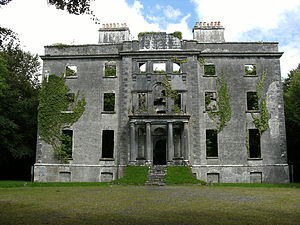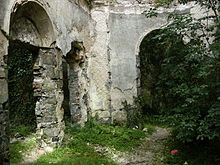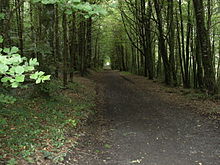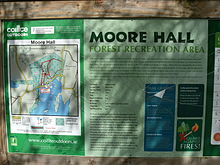- Moore Hall, County Mayo
-
Moore Hall, or Moorehall, the house and estate of George Henry Moore and family, is situated in the barony of Carra, County Mayo in a karst limestone landscape. The Moores were an aristocratic Irish family who built Moore Hall between 1792 and 1795. The first Moore of Moore Hall was George Moore, a name borne by many members of the family down the generations. The Moores were originally an English Protestant family but some became Catholic when John Moore married the Catholic Jane Lynch Athy of Galway, and when their son, George, married Katherine de Kilikelly (really Kelly), an Irish-Spanish Catholic, in 1765. [1] [2]
The ruins of the Moore family's large stately home, Moore Hall, lie on Muckloon Hill overlooking Lough Carra. [3] The house was designed by John Roberts, an architect from Waterford who also designed Tyrone House in Co. Galway, and Waterford Cathedral. Several members of the Moore family played major parts in the social, cultural and political history of Ireland from the end of the eighteenth century to the early twentieth century. The house was burned down in 1923 by anti-Treaty irregular forces during the Irish Civil War because Maurice Moore was viewed as pro-Treaty. [4]
Contents
The Moores of Moore Hall
Notable Moores include:
- George Moore, who built the estate
- John Moore, first President of Connacht, 1798
- George Henry Moore, statesman and provider of famine relief
- George Augustus Moore, writer, novelist, and co-founder of the Abbey Theatre
- Senator Colonel Maurice Moore, first Irish envoy to South Africa.
History
- George Moore (1727-1799), who built Moore Hall, originally came from Straide near Castlebar. During the time of the Penal Laws, George went to Spain where he was admitted to the Royal Court. From the 1760s until about 1790, George made his fortune in the wine and brandy trade, running his business from Alicante. When the Penal Laws were relaxed at the end of the 18th century, he returned to County Mayo with a fortune of £200,000 and in 1783, bought over 12,000 acres (49 km2) of land at Muckloon, Ballycally and Killeen from Farragh Mc Donnell, and commissioned the building of the grand residence of Moore Hall. [5]
- George's son, John Moore (1767 - 1799), was educated in France and became a lawyer. With the rebellion of 1798, he returned to Mayo. General Humbert appointed him President of the Connacht Republic in Castlebar. Thus, John Moore was the first President of an Irish republic, albeit for a very brief interval. He was captured by the English Lord Cornwallis, and although initially sentenced to death, his sentence was later commuted to deportation. He died in the Royal Oak tavern in Waterford on 6 December, 1799. [6] His body was exhumed from Ballygunnermore Cemetery in Waterford in 1962 and brought to Castlebar, where he was buried in the Mall with full military honours. [5] [6]
- George Henry Moore (1810 - 1870), was educated in the Catholic faith in England and later at Cambridge University. His main interest was in horses and horse-racing. His brother, Arthur Augustus, was killed after a fall from the horse Mickey Free during the 1845 Aintree Grand National. At the height of the Great Irish Famine in 1846, he entered a horse called Coranna for the Chester Gold Cup and netted £17,000 from bets laid on the horse. During the Famine he imported thousands of tons of grain to feed his tenants, and gave each of his Mayo tenants a cow from his winnings. It is still remembered on the Moore estate that nobody was evicted from their home for non-payment of rent during hard times, and that nobody died there during the Famine. George Henry is buried in the family vault at Kiltoom on the Moore Hall estate. [2] [7]
- George Augustus Moore (1852 - 1933), was a distinguished writer of the Irish Literary Revival period. Many famous writers of the time, including Lady Gregory, Maria Edgeworth, George Osborne, and W. B. Yeats were regular visitors to Moore Hall. George was an agnostic, and anti-Catholic. [4] His ashes are buried on Castle Island on Lough Carra in view of the big house on the hill. [3]
- Maurice George Moore (1854 - 1939), Senator Colonel Maurice Moore was the statesman of the family. He served with the Connaught Rangers in the Boer War and became concerned with human rights in South Africa. He also worked to relieve Irish prisoners held in English jails, and for the retention of UCG when it came under threat.[clarification needed what was the threat?] He was also involved with the co-operative movement in Ireland, founded by Horace Plunkett.
Moore Hall house was burned down on 1 February 1923 during the Irish Civil War. An account of the burning was given shortly afterwards by the owner in a letter to the press.
Moore Hall today
The house, lake, farm, and estate is now owned by the forestry company, Coillte, and it is popular with visitors to the area. The house is not open to the public due to its poor condition — it has not been refurbished since it was burned. The estate is a haven of native forestry grown over the farm walls and buildings behind the ruins of the grand house. Local people who lived and worked on the Moore Hall estate remember it fondly. [3] The estate passed to the Irish Land Commission upon the death of George Moore, and a campaign to restore the house has been waged. [4]
Pictures
External links
- Moore Hall website
- Moore family record at the Landed Estates Database, NUI Galway.
- Estate record at the Landed Estates Database, NUI Galway.
A 37-minute documentary about Moore Hall, recorded in 2001, is available in three parts:
- The House introduces Moore Hall house and the history of the estate.
- The Lake describes the nearby Lough Carra, and visits George Augustus Moore's grave on Castle Island.
- The Farm documents the farm and its buildings, and the garden and orchard.
References
- ^ The Moores of Moore Hall, by Joseph Hone; Jonathan Cape, London 1939
- ^ a b George Moore, 1852-1933 by Adrian Frazier, Yale University Press. Extensive section of book quoted at New York Times (subscription required). Retrieved 2010-07-27
- ^ a b c The Lake, video at oreillydesign.com. Recorded 2001. Retrieved 2010-07-27
- ^ a b c Moore Hall, Co. Mayo, North Atlantic Skyline. Retrieved 2010-07-27.
- ^ a b The Moores of Moorehall by Kevin Coyne, mayo-ireland.ie. Retrieved 2010-07-27
- ^ a b Moores of Moorehall, oreillydesign.com. Retrieved 2010-07-27
- ^ Moores of Moorehall, County Mayo, Ireland, History, mayo-ireland.ie. Retrieved 2010-07-27.
Coordinates: 53°42′48.3372″N 9°13′34.122″W / 53.713427°N 9.226145°W
Categories:- Buildings and structures in County Mayo
- Houses in the Republic of Ireland
Wikimedia Foundation. 2010.





